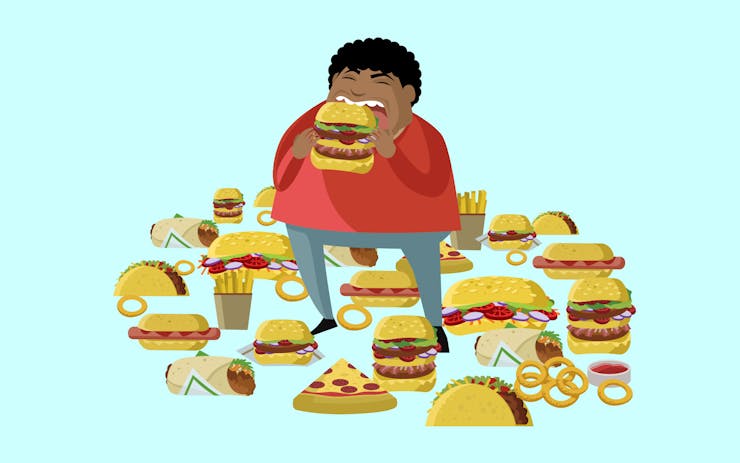Every cannabis consumer knows that strain of Presidential OG may inspire you to finish an entire bag of stale potato chips, with no regard for the consequences. But why?
That question has had Jon Davis hot-boxing lab rats for the past year.
'There's some very powerful communication between the gut and the brain.'
Davis, a Washington State University assistant professor in integrative physiology and neuroscience, has spent much of the past 12 years studying how the gut affects the brain, mainly through bariatric surgery work at the University of Cincinnati. There, he learned that the gut’s control of behavior goes beyond alerting us to eat. It also impacts mood, motivation, learning, and even addiction behaviors.
“We discovered that when you do weight loss surgery or bypass surgery on people, someone who previously never drank alcohol [may] turn into an alcoholic,” Davis said. “It actually clued me in to this very powerful communication between the gut and the brain.”
Regulating Appetite
The system in the brain that communicates dominantly with the gut about appetite is the endocannabinoid system. It’s expressed throughout the central and peripheral nervous systems and regulates physiological and cognitive processes like fertility, reward, appetite, mood, and memory.
It’s also where CB1 and CB2 live. Those are the two dominant cannabinoid receptors in charge of mediating the effects of cannabis. This suggested to scientists an explanation for why appetite is stimulated in cannabis consumers.
In the early 2000s, scientists in Europe set out to confirm their hunch. They discovered that cannabis not only stimulated appetite in the endocannabinoid system, but that they could design a compound to reverse appetite, and other motivations. That CB1 antagonist was the compound SR 141716, also known as rimonabant.
The most apparent effects of rimonabant was in how it helped people lose weight by completely rewiring how the brain interpreted reward, and thus, appetite. “It would cure whatever ailed you,” said Davis. “If you overate, you stopped. If you were a cigarette smoker, you stopped smoking cigarettes.” Scientists felt they had hit the bad-habit cure-all jackpot.Looking for Legal Cannabis?
Wonderdrug? Not So Fast
In 2006, rimonabant went into a widespread trial phase (and became commercially available in some countries) as a drug intended to improve overall cardiovascular health by reducing appetite, food consumption, and obesity. It was looked at as a potential “miracle” weight loss drug.
Previous attempts to find appetite-suppressant drugs became cautionary tales.
After a two-year study involving more than 18,000 patients, the drug trial was shut down early due to a disturbing potential side effect. As The Lancet reported, there were “concerns by health regulatory authorities in three countries about suicide in individuals receiving rimonabant, both in clinical trials and among those taking the commercially approved drug for weight loss.” (The drug was available in Europe, but not in the United States.)
Rimonabant became a cautionary tale of the potential and the power of both cannabinoids and the connection between the gut and the brain.
“[All of this] clued me in to the idea that, you know, if you look at the way marijuana controls feeding you could learn a lot about how to turn on and off the reward or motivation system,” Davis said. “And that’s really important for people that have feeding pathologies.”
Shop highly rated dispensaries near you
Showing you dispensaries nearVaping Like the Humans Do
Fascinated by the complex connection between the gut and brain, Davis wanted to follow this path further and push for more specific results, and he wanted to do it his own way.
Instead of injecting the rats with THC, like most scientists have done, Davis wanted his method to bear a clearer resemblance to the way cannabis is actually consumed. He decided to vaporize plant matter. “Because who injects THC in their arm?” Davis explained. “Knowing how vaporized plant matter or flower stimulates a behavioral change is a major advance, I feel.”
So, about a year ago, he requested the money and supplies he needed to build a chamber where he could expose rats to vaporized cannabis. The government provided his lab one strain of cannabis to test, a sativa at about 7.8% THC.
“We did a dose response because that’s the right thing to do – and because you can’t ask a rat if it’s high,” Davis said. He and his team determined that about ten minutes after initial exposure, the THC levels in the rats’ blood was high enough to trigger feeding.
Then, they used epigenetics – the study of how the environment impacts genome in real time – and MRI-like imaging of the hypothalamus, the center of the brain that controls appetite, to see how marijuana changed rats’ behavior on the molecular level. Until this point, research had only confirmed that it does stimulate appetite, but now, they can explain how specifically.
Glutamate Sparks Feeding
The first thing Davis found is that cannabis impacts the genes that encode glutamate, a major type of excitatory neurotransmitter that sparks feeding in the hypothalamus. When glutamate is increased in an animal, they feed. When it’s decreased, as it was after cannabis was given to the rats, appetite is suppressed.
“So, we were like, ‘oh, maybe that’s what’s going on.’ Maybe initially when we give them weed they don’t think about eating, they think about the psychoactive properties of the drug,” Davis said.
But Then There’s ‘Grehlin’
But eventually, the rats would find their way back to the food dish. Davis’ hunch was that there was then something going on with grehlin, a hormone found in the stomach, based on previous research with grehlin and appetite stimulation.
Sure enough, Davis and his research partners found that after exposure to cannabis, grehlin levels began to gradually climb in the animal. Thus, they concluded, there was a sort of balancing act going on between glutamate and grehlin, a relationship somehow modified by the consumption of cannabis.
“We figure right after the rat consumes marijuana, grehlin can’t really do its thing because the glutamate is turned off,” said Davis. “But when that turns back on, grehlin can work and that’s when you have appetite again. That’s why there’s a delay.”
Understanding that delay could potentially allow us to harness the appetite mechanism, Davis said. That could mean helping people who need their appetite switched off, like those struggling with obesity, and conversely, being able to switch appetite on for anorexics and cancer patients.See What's On Today's Menu





